Three years later we came back to Lapland and spent first one month at Kvikkjokk Tourist Station, further south than Abisko. We rented a ilittle red house with one room and a kitchenette that was part of the STF tourist station. We cooked our own food and did our shopping at the general store in the village. It was a good walk, but that’s what we needed to prepare us for what was coming.
After that first month, Arne went back to civilization, having had enough of trekking on our first visit to Lapland. Mother, Gun and I set out on a two-week trek around Sarek National Park, one of the wildest and most scenic mountain areas in the world. Each one of us was carrying over 20 kg on our backs, as we set out.
We started out on the light climb from the tourist station into the birch forest. We were provided with jungle oil and birch branches to fight off the mosquitoes. Kvikkjokk is a mosquito paradise and I vividly remember a white wall in the laundry room that was black with huge mosquitoes.
To begin with, we were headed for Saltoluokta on a four-day trek. This part of Kungsleden is far less well known and visited than the stretch we covered in 1947 and it’s sheer magic.
After two days of that first leg from Kvikkjokk to Saltoluokta we arrived at Aktse — after spending the first night at Pårtastugan (stuga=hut) This is one of the main entrance sites for those strong people who plan on getting into the magic Sarek massif, carrying tents and sleeping bags. Unless they have a guide who carries the tent, in those days they ended up with 40 kilos on their backs. But that was then and clearly tents and everything else has become far more light-weight today. Sarek National Park is protected and there are no huts or shelters of any kind.
The view from Aktse over Rapadalen with its delta is unique. There is a very scenic delta in Kvikkjokk too, but the Rapa valley is truly breathtaking. Unfortunately Mother’s photos and films were lost, and I have no idea how that came about.
The next-day trek from Aktse with the surreal beauty of the lake Sitojaure (jaure = lake) ended with a fairly long boat ride across the lake. In those days (1950) you were taken across the fairly big lake by a Sami man in a rowboat. Oh people would laugh at that today when there is a motorboat that takes you across to the hut Sitojaurestugan,
Back to the Sami man — he was not on our side when we got to the lake. He saw us and he rowed over, which took a while. However, when you hike in Lapland you get to learn about patience. So we waited. It felt good sitting down in his rowboat and being taken over to the Sitojaure hut by someone else’s manpower. Obviously you paid the man, who was clearly making his living in this way during the short summer months.
The site of the hut was sheer beauty, overlooking the lake.
The next day we had the most wonderful surprise on our sighting lake Langas that Saltoluokta Tourist Station is situated by. Lake Langas is one of the many lakes that make up what is called Stora Lulevatten.
This was the end of the first leg of our trek around Sarek.
Saltoluokta is certainly one of the most beautiful places in Lapland, overlooking gorgeous Lake Langas. The last kilometer or so was downhill among the gnarlied birches There was also a wonderful tourist station and that evening we did not have to eat our vacuum packed food.
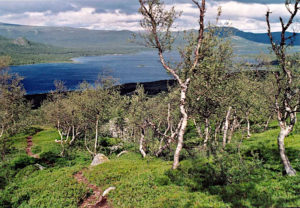
A view of Lake Langas, seen through the gnarled birch forest from above Saltoluokta tourist station (2002)
Already in 1950 it was a comfortable place as compared to the huts we had stayed in on the way. I do believe food was served already in those days. There are several houses now, one for hikers who prefer to cook their own food, and a couple of small ones (ours in 2002 and 2003, called Laponia for instance) for more spoiled people who want beds with sheets.
In 1950 we didn’t stay around, but went up the chain of lakes called Stora Lulevatten. Today you go by bus, but in those days the road on the northern side of Lake Langas didn’t exist yet. So traveled on by boat..
We first took one boat to Suorva Kraftstation, a power station — alas, Stora Sjöfallet had been minimized by it. But hydro-electric power is still cleaner than most other kinds of power.
In Suorva there was a small tourist station at the time, where we had a very pleasant lunch. There we changed boats, obviously because of the change of levels where there was once a majestic waterfall. The power station dates from early 20th century, but a good part of the original waterfall has been preserved.
In 1950 we clearly walked up a hill from the first boat landing to get to the tourist station. Stora Lulevatten is a chain of lakes and rivers that stretches from close to the Norwegian border to the center of Sweden, where it becomes a huge river, called Luleälv, which empties into the Bothnian Bay at the city of Luleå.
Today you take a bus, that picks you u after a brief boat ride p across Lake Langas from Saltoluokta Tourist Station. The bus takes you to Ritsem, where we, older now in 2002, took the helicopter to Staloluokta.
The boat from Suorva took us along all the way to wonderful Vaisaluokta, a Sami summer village. It was very complete with the most beautiful timbered church I could ever imagine. There is now one small Sami church in Staloluokta, where we were going, but it is not nearly as overwhelming as this one.
The Sami people were Christianized in the mid 19th century by pastor Lars Levi Laestadius. Well, someone was bound to come along and meddle with the lives of the Sami people. It turns out, however, that Laestadius actually saved the Sami from destroying themselves by alcoholism.
You had an almost religious feeling of awe because of the simple beauty and the high ceiling, the light-colored fresh wood and everything just exquisitely beautiful and simple. There were reindeer fells covering the floor to sit on.
We were so impressed by the friendliness of the Sami people, men, women and children, that we decided to spend a whole day there. A Sami woman who looked a hundred years old, and who was probably not young, a kind of tribal mother, invited us proudly to see the interior of her huge hut (lappkåta in Swedish). There was room for a whole family there, with children and grandchildren – AND she had a Singer sewing machine. A treadle one, for obvious reasons.
We spent two nights in a Sami hut for tourists, sleeping on reindeer fells over us and under us. They covered a bed bottom of soft birch branches on the floor. I have never slept better. We cooked our food in a huge pot hanging on a chain from the center hole over the hearth in the middle of the hut. The opening lets the smoke out of course.
We spent a day just walking around talking to the locals and taking pictures (which have been lost, alas!). The old woman let Mother take pictures of her, even though we had been told that the Sami people believe evil spirits will get them if they have their pictures taken. It was a day that will never be forgotten.
The saddest thing about this is that the whole village was burned down a couple of years later, by a madman, pyromaniac, as far as anyone knows. The original kind of Sami village was never reconstructed, and it is so sad to think of all that ‘history’ being gone and forgotten. There is now in its place a fishing village with Sami people no doubt.
We have been told though that the beautiful Sami church was in fact spared. There are new pictures to be found of an old church that looks very much like the one we saw in 1950. Today, there is an STF hut in Vaisaluokta and also in Kutjaure, where there was absolutely nothing when we took the boat there in 1950, headed for Staloluokta..
____________________
After the day in Vaisaluokta we waved goodbye to our new friends and set out towards Staloluokta. This was to be the point of our two-week trek that made me insist on going back to Lapland with John many decades later. After all our summers in the Austrian Alps, I just felt I had to revisit the paradise of my youth. Both these places have since then become Sami summer villages – no more with Sami huts, but with wooden houses. We know that now it’s possible to buy some kinds of food, smoked trout and pita-like bread in Stalo and certainly also in Vaisaluokta.
In those days there was no trail from Vaisaluokta to Staloluokta and this enormous area, possibly the most wonderful wilderness area in Europe, had not yet been made into the Padjelanta National Park, which is now the largest national park in Sweden. It covers the area from the western end of Sarek National Park all the way to the Norwegian border. Since there was no trail back in 1950, we had planned on taking the boats run by Sami people from Kutjaure. In the 21st century there were no more boats. All that is history that I have inside me. On our way to Kutjaure, in fact, we got a bit lost and that is when we found a reindeer horn that we later put up over the wide door to Mother’s room in Malmö. After a few hours hike we finally got to the boat dock – just in time.
This was a bit unnerving, and since we were not the only passengers, it almost seemed as if the ‘captain’ had been waiting for us. The boat took us first down a river to Lake Vastenjaure After that first half of the trip we walked across a spit of land and changed to another boat from the northern end of Virihaure. The whole crossing took a few hours and we arrived at Stalo towards the evening.
Vastenjaure and Virihaure are called the Great Lakes of Lapland (Stora sjöarnad) and they go all the way down to Stalo and to the Norwegian border.
he authentic Sami hut where we were going to spend the night was already occupied when we arrived. No problem – there was room for all of us. That’s how we made the acquaintance of a gentleman who was so much in love with Stalo that he just felt he had to come here every year for a few days to get cleansed from the noise and dust and ugliness of the big cities. To breathe the peace and silence into his soul for another year. Virihaure and Vastenjaure have rightfully been called the most beautiful lakes in Sweden.
We stayed in Stalo for a full day and we felt we could sit there eternally and just let the calm and beauty of the place seep though us. This was a world I had never known. This was my dreamland. I felt I could stay right here forever watching the line of snowy mountains on the far side of the lake, in Norway, and the changing colors on the water.
___________________
The next morning we had to set out on the last leg to get back to Kvikkjokk, where we had started our trek around Sarek. The first day would be a long one, thirty kilometers, all the way to the Tarraluoppal hut, since back in those days there was no STF hut closer to Stalo.
We were going to experience a type of flora in Tarradalen that is absolutely unique in Sweden. After the first long day to Tarraluoppal you get into birch forest and you are in the Tarra valley. This unique valley has a micro-climate that makes usually knee-high flowers grow to be sometimes over two meters high. It was truly amazing. Monkshood (stormhatt, Aconitum lycoctonum) and equally enormously high queen Anne’s lace (hundloka, Anthriscus sylvestris) are the plants I particularly remember. They were actually towering over us. Also, of course, there were globe flowers (smörbollar) and rosebay willowherb (mjölke) everywhere and masses of fern in this birch forest. We felt as if we were hiking through a sub-tropical valley. Yet, on both sides there were high mountains, since we were walking very close to the southwestern border of the Sarek massif.
It’s a good thing one more hut, Tuottar, has been added on that long stretch.
The stretches after Tarraluoppal were of more normal length. Our only problem was that we were running out of food. In those days there was no place where you could buy food. Things have indeed changed! I remember that the last day we cooked some kind of bread (we obviously had brought some flour – strange!) on an open fire, mostly flour, water and a pinch of salt I guess. A very good friend of mine, wonderful Aina, who was an inveterate girl scout had taught me how to make that kind of bread on a stick and now it came in very handy. We were surrounded by cloudberries as well, and we ate a lot of them. So pinnbröd and cloudberries were our diet on the last day.
The trek from Njunjes to Kvikkjokk short, so we got to the tourist station in the afternoon, to a comfortable room with a BATH and a real dinner. We all got to bed pretty tired that evening.
The biggest adventure in my life was over. But never to be forgotten.
Link to Siv’s album here.
Continued: Chapter 4 – My youth and the theater


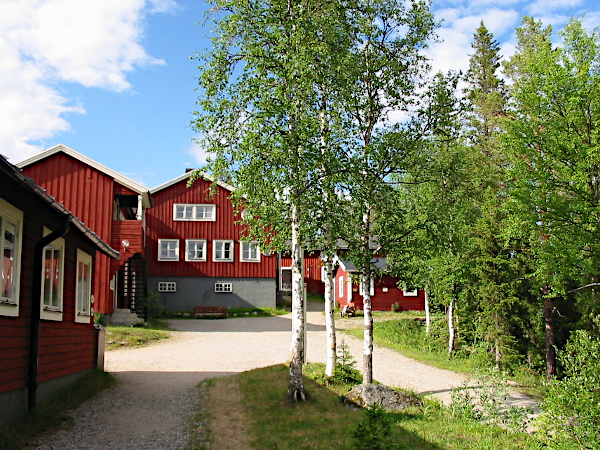
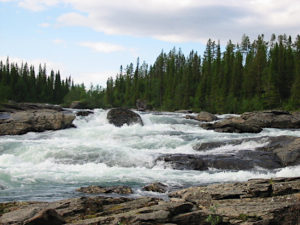
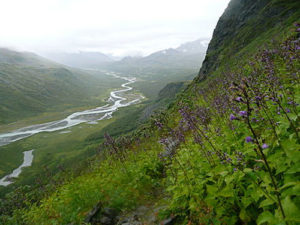
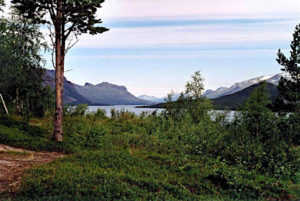
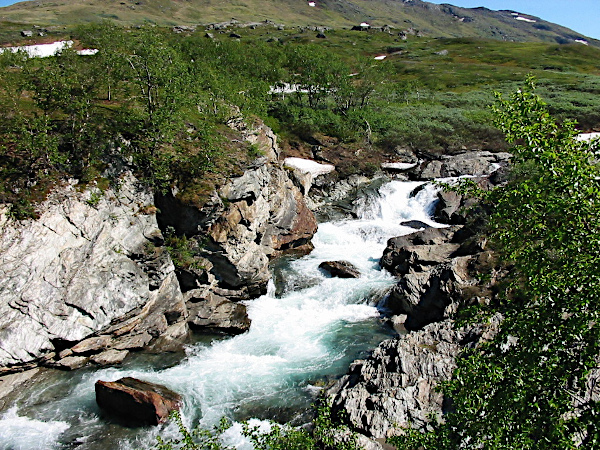
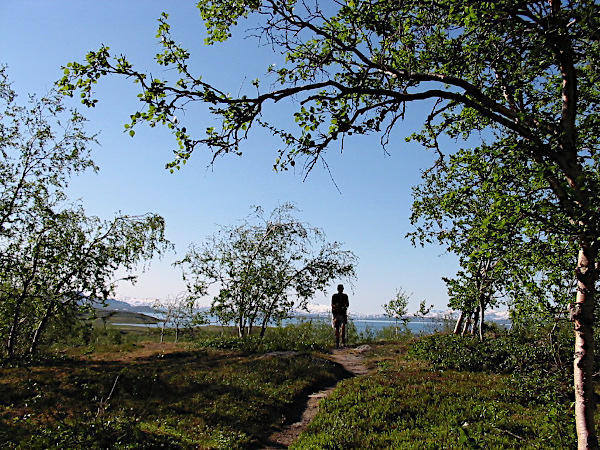

Pingback: Sketches from the Life of a Wandering Swede | Siv’s sketches from her life